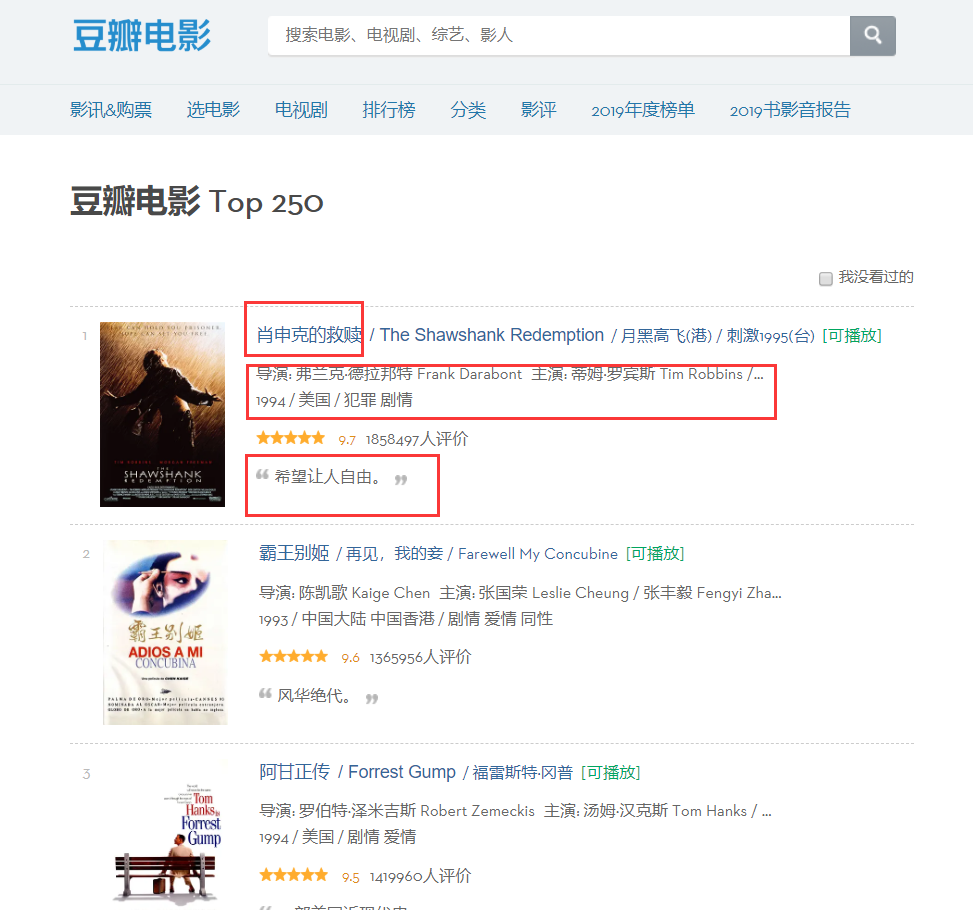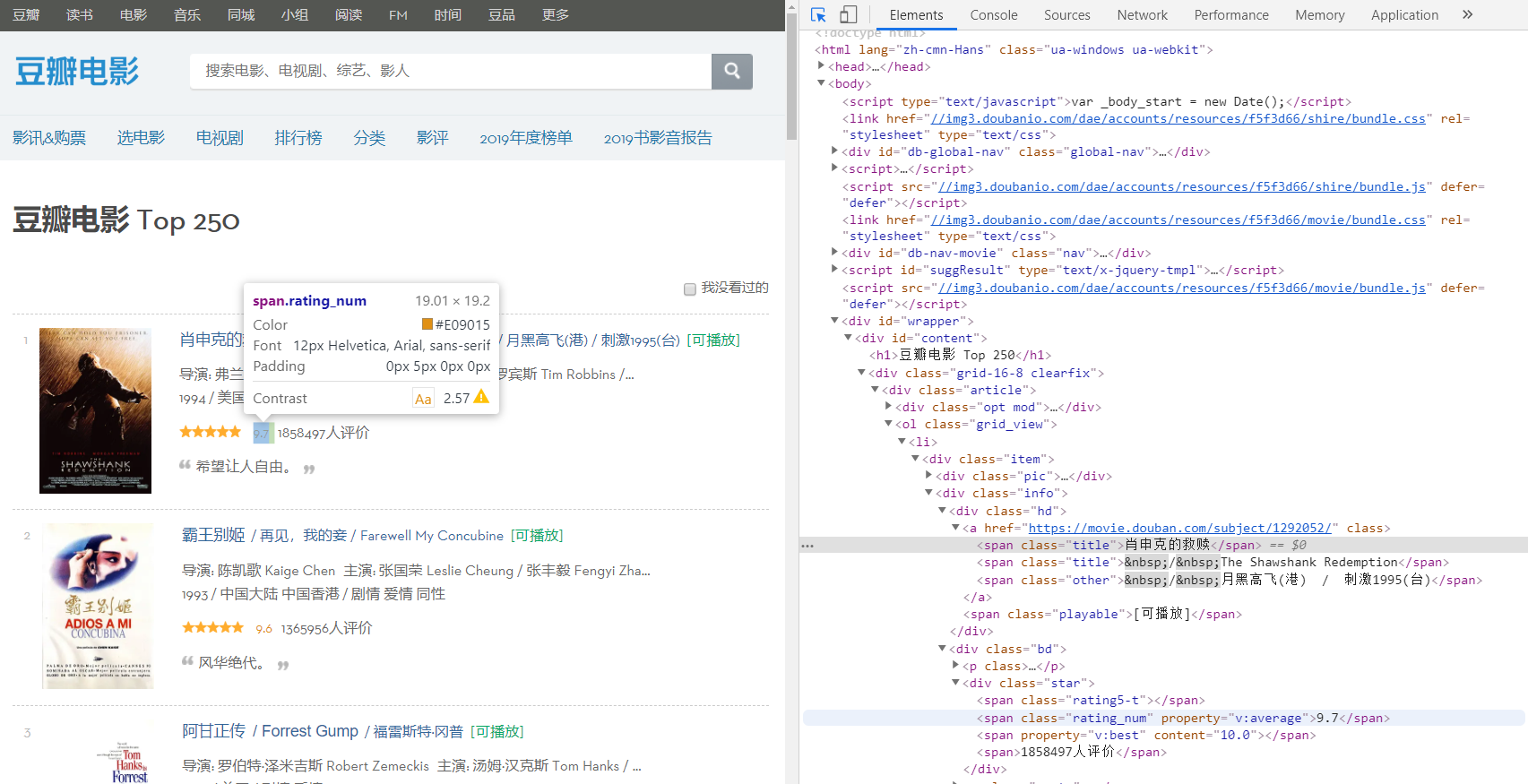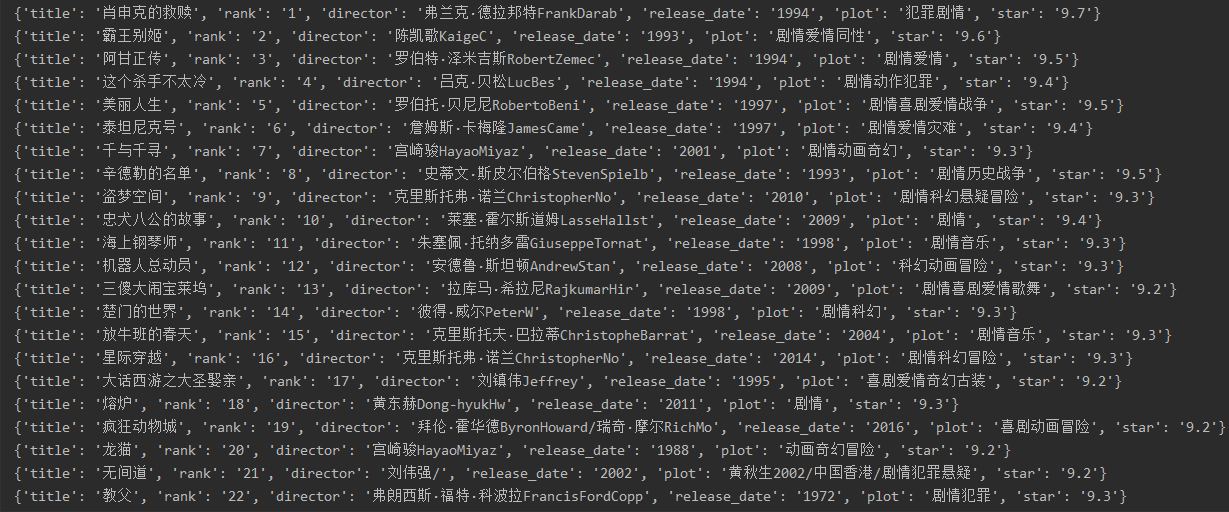Python爬虫入门抓取豆瓣内容二
点击打开在线编译器,边学边练
1. 问题分析
我们在上一节爬取了网页的全部信息,下面我们还要这样html代码中找到我们所需要的内容,因此我们要根据问题进入网站中,去解析网页中的信息。

从页面中可以发现,我们需要爬取的信息分别存在于不同的分区当中,那么我们来检查一下页面的元素,右键页面检查网页源代码或者F12。

在分析网页之前,我们先规定一下解析之后的存储方式,这里我们采用列表来存储所有的信息,然后列表中的每一项对应一个字典,每一个字典再对应多种信息。
movies = []#首先定义一个列表来存储所有信息
通过分析我们可以确定title的位置是名为‘hd’的‘div’下的第一个‘a’中的第一个‘span’,因此我们可以通过下面代码来锁定每一个电影的名字,然后放到一个字典中。
moviename = each.find('div', class_='hd').a.span.text.strip()
movie['title'] = moviename#字典的一项相同的方式可以再根据定位找到导演名的源码,但是这个源码中包含了很多信息,所以我们要通过正则表达式进行过滤。

info = each.find('div', class_='bd').p.text.strip()首先找到了这个标签下的所有内容,我们再通过正则表达式过滤掉无关信息。
info = info.replace('\n', "")#过滤回车
info = info.replace(" ", "")#过滤空格
info = info.replace("\xa0", "")#过滤不间断空白符
director = re.findall(r'[导演:].+[主演:]', info)[0]
director = director[3:len(director) - 6]然后定义为字典的一项。
movie['director'] = director#字典的一项
我们可以发现电影类型也在这个‘p’标签中,我们也直接通过正则表达式来获取该信息。
plot = re.findall(r'[0-9]*[/].+[/].+', info)[0]
plot = plot[1:]
plot = plot[plot.index('/') + 1:]
plot = plot[plot.index('/') + 1:]
movie['plot'] = plot#添加为字典的 一项最后再锁定评分信息。
star = each.find('div', class_='star')
star = star.find('span', class_='rating_num').text.strip()然后继续以字典的形式保存。
movie['star'] = star
最后把这个字典添加到列表中并遍历输出。
movies.append(movie)#把字典加到列表中 for i in movies:#遍历输出 print(i)
2. 完整代码
import re
import requests
from bs4 import BeautifulSoup
for i in range(1):
headers = {#模拟浏览器进行访问
'user-agent': 'Mozilla/5.0 (Windows NT 6.1; Win64; x64) AppleWebKit/537.36
(KHTML, like Gecko) Chrome/52.0.2743.82 Safari/537.36',
'Host': 'movie.douban.com'
}
res = 'https://movie.douban.com/top250?start='+str(25*i)#25次
r = requests.get(res, headers=headers, timeout=10)#设置超时时间
soup = BeautifulSoup(r.text, "html.parser")#设置解析方式,也可以使用其他方式。
div_list = soup.find_all('div', class_='item')
movies = []
for each in div_list:
movie = {}
moviename = each.find('div', class_='hd').a.span.text.strip()
movie['title'] = moviename
rank = each.find('div', class_='pic').em.text.strip()
movie['rank'] = rank
info = each.find('div', class_='bd').p.text.strip()
info = info.replace('\n', "")
info = info.replace(" ", "")
info = info.replace("\xa0", "")
director = re.findall(r'[导演:].+[主演:]', info)[0]
director = director[3:len(director) - 6]
movie['director'] = director
release_date = re.findall(r'[0-9]{4}', info)[0]
movie['release_date'] = release_date
plot = re.findall(r'[0-9]*[/].+[/].+', info)[0]
plot = plot[1:]
plot = plot[plot.index('/') + 1:]
plot = plot[plot.index('/') + 1:]
movie['plot'] = plot
star = each.find('div', class_='star')
star = star.find('span', class_='rating_num').text.strip()
movie['star'] = star
movies.append(movie)
for i in movies:
print(i)3. 运行结果
控制台:

4. 总结
在这个实例中,我们主要学习如何去网页的源码中找到相应的信息,BeautifulSoup可以帮助我们迅速定位,再结合正则表达式来完成信息的匹配,下一节我们把这些数据保存到数据库当中。
本文固定URL:https://www.dotcpp.com/course/329